The Chives are delicious herbs that add a great addition to meals and snacks. Most gardeners grow Chives outside or in pots indoors on their kitchen windows. Chives can easy to grow and can adapt to different conditions. However, sometimes they are prone to various physiological disorders and environmental stress, which does not result in the Chives growing properly. Moreover, these problems interfere with the plant’s average growth cycle and development.
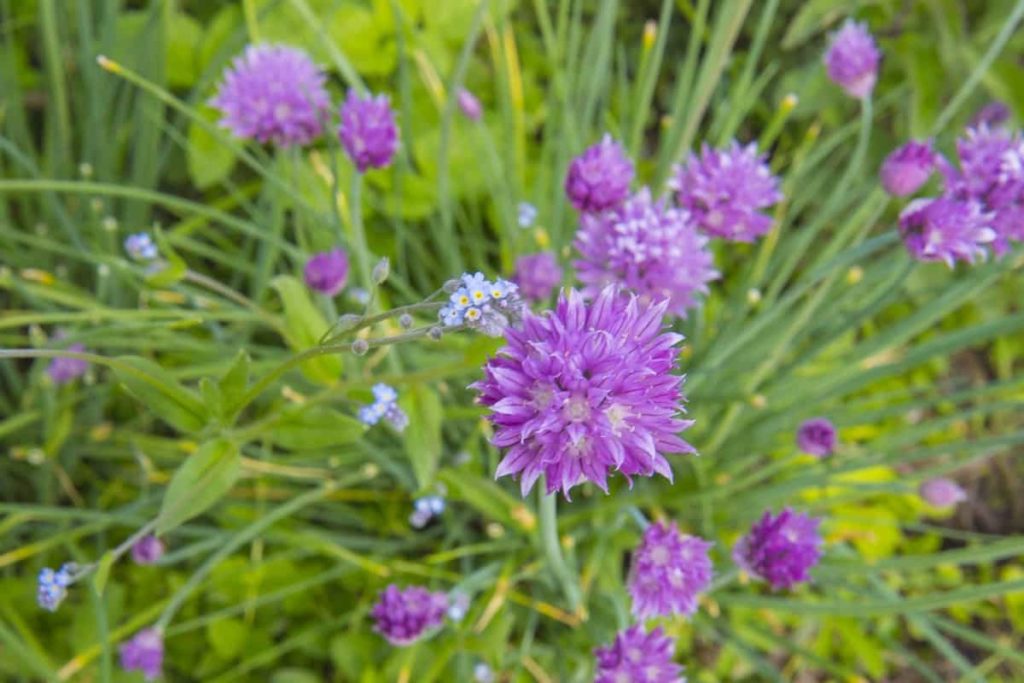
So while it may be great to plant and grow or produce your herbs, it can be equally disappointing when it doesn’t grow as expected for mysterious reasons. Fortunately, your plant will usually signal something wrong, so you can step in. The biggest problems growing Chives are pests, Chives that are not growing, drooping Chives, colorless leaves, and Chives that don’t grow (straight). The primary solution is to give your Chives less water, clean soil, and pots, and keep a close watch on their health.
Common Chive plants problems
Chives are not growing
Overwater or underwater
Overwater can also cause bacterial growth and root rot, as well as the collapse of the entire plant. However, underwater causes stunted growth and tasteless Chives.
Solution – Avoid overwatering your Chives; keep the soil moist at all times, but never wet or soak. Water-logged roots are the worst enemies of Chives. Ensure that the Chives are planted in pots/containers with drainage holes. Place a saucer and empty excess water under the container while watering the indoor Chives.
If the leaves are light and crispy, it means you are underwater. Check the soil moisture more often with toothpicks and water. Be sure to adapt your water schedule to the weather and temperature.
Solution – If the soil is more drained, give the Chives plenty of water on hot summer days; if the ground is moderate to slow drainage, water the soil less frequently. Always check the soil before watering.
Excess water salinity
Excess water, less water, and excess salt content in water negatively affect the natural growth of herbs in your garden.
Solution – If you are using water from unknown sources, it is recommended to check the water for salt content. You can also check the amount of salt in water if you have a refractometer or a hydrometer.
Insufficient light exposure
Chives are not growing because of insufficient light. Chives need at least six to eight hours of sunlight daily for proper growth.
Solution – If you are growing Chives indoors, keep them on sunny windows. But always avoid facing windowsills that don’t get much light. South-facing windows get maximum sunlight during the day. So if you’re growing in a place in your garden with limited sunlight exposure, you can see it replanting at a different location. Also, avoid garden spots that remain very wet after heavy rain as they cause rot.
Insufficient temperature
The ideal temperature of growing Chives drops between 4 to 29°C. At this temperature, the Chives will thrive. When the temperature is below 4°C, the herb will enter a dormant state, and its growth and development will cease.
Solution – If you have Chives in the garden and get low temperatures in winter, you can divide a clump (if possible) and take it indoors for the source of fresh winter Chives. In case of extreme heat, ensure regular water Chives. This exercise protects the plant from sunburn and various other problems.
If growing outside, keep them a little away from the windows, as glass can cause a significant spike in temperature (so burn the plant). Instead, open windows to exchange good air. Cover the herbs during freezing temperatures with a plastic bag or gardening cover.
Pest attack
Pest attack is another major problem that can interfere with the natural growth of the Chives.
Solution – Plant insect’s sticky traps. You can shake the herb or use water to remove the thrips and pests manually to remove the thrips and pests. Use natural pesticides such as neem oil, gardening oil, or thus insecticidal soap to control the thrips and many other insects.
In case you missed it: Best Fertilizer for Chives: Organic, Homemade, Liquid, Compost, NPK, Natural, How and When to Apply
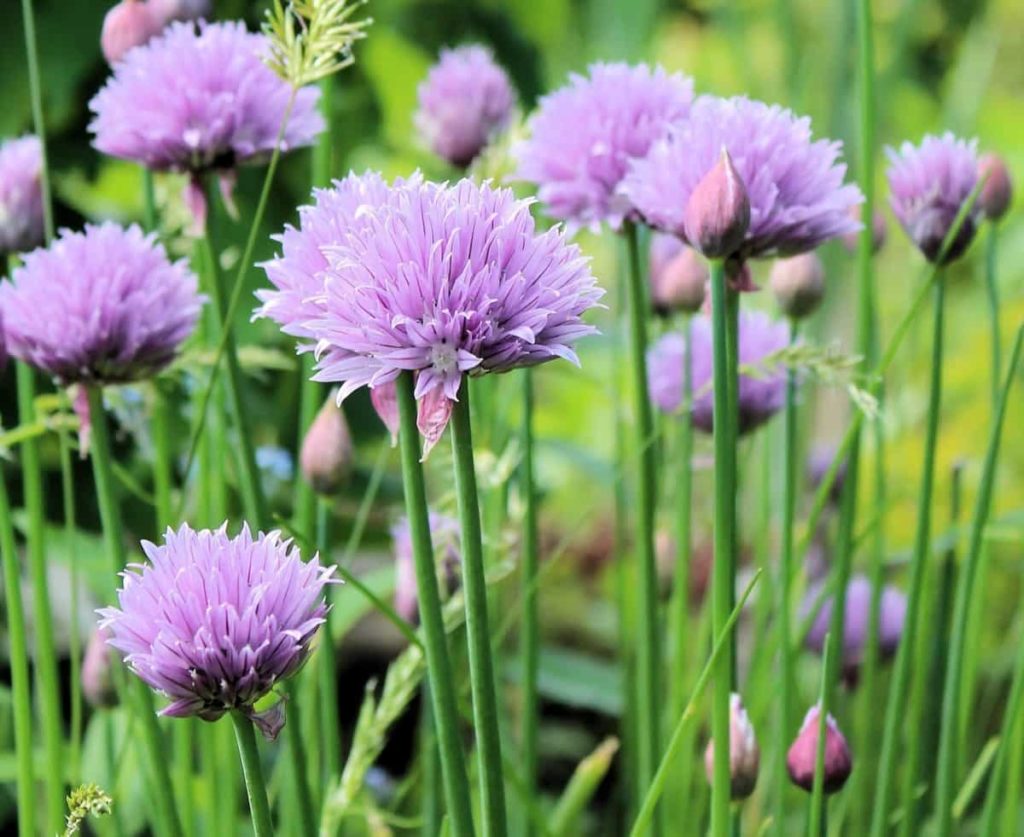
Nutritional deficiency
If Chives are not getting enough nutrients, it will stunt the herb’s growth.
Solution – To keep your herb healthy and happy, apply organic or synthetic fertilizer whenever the leaves have started to yellow. The yellowing of leaves signifies a lack of nutrients in the soil. Applying fertilizers at recommended rates helps the Chives to create high foliage and a strong root system. However, too much fertilization, especially using fertilizers with a high nitrogen ratio, can burn the Chive plant and cause weak roots. This will result in more diseases and diseases.
Lack of space
The Chives like open spaces to grow and thrive. So while they may adapt to small spaces, they need some proper space to grow properly.
Solution – If you grow Chives in pots, make them repot when they are root bound. It will provide fresh nutrients and space to the growing plant.
Lack of harvesting
If your Chive creates large clumps, it will have less space to grow further.
Solution – Harvest regularly to boost growth in the Chives. Once your Chives grow well, you need to cut them 1 to 3, even four times a season.
Chives seeds are not germinating
Indoors can control temperature, and the moisture content receives seeds, which are both important if you want these Chives to germinate.
Solution – Fill a flat with moist potting soil; make sure it is about 2 inches deep. Place a tray under the flat to catch the draining moisture. Take the seeds and place them on top of the soil in a row, making sure there is about 1 inch between the seeds and about 2 inches between the rows.
Push the seeds into the soil and cover them with just so much soil to cover them almost. Use only a spray bottle filled with water, the seeds through the fog. Cover the seed flat with a plastic bag to ensure the moisture is closed, so they don’t need more water until they sprout. Seeds should sprout after about a week.
Chive leaves turning yellow or brown
Lack of space
If your Chive plant doesn’t have enough place to grow, some leaves may start to yellow.
Solution – If the leaves have turned completely yellow, it is time to cut them because they will not be fine. When your plant is relatively old, it may also turn some leaves yellow.
In case you missed it: Growing Chives in Pots, Planting, Care – A Full Guide
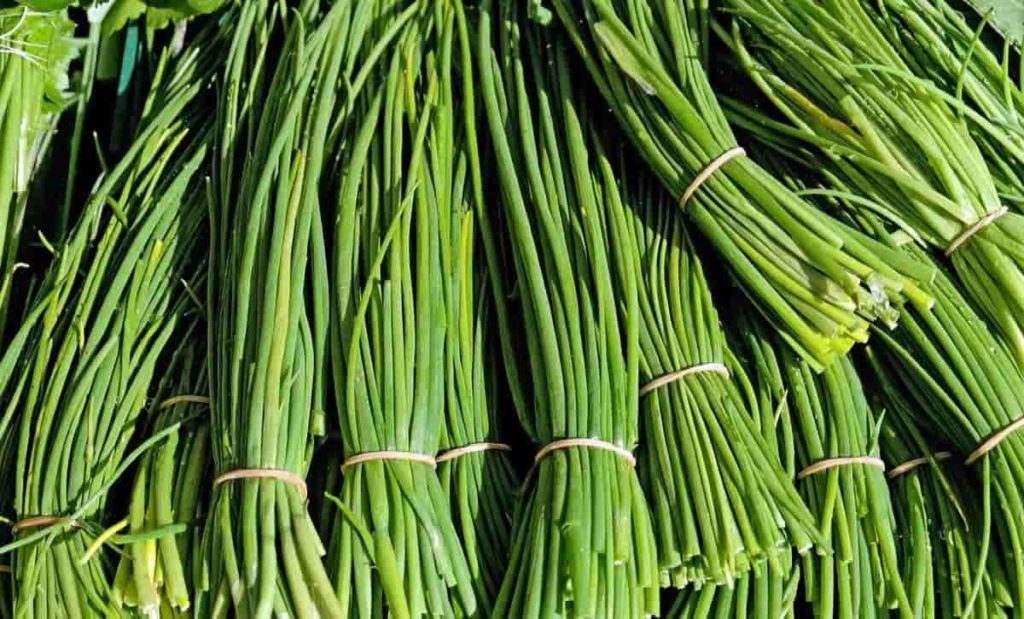
Nutrient deficiency
When your Chives lack nutrients, their leaves can be brown yellow.
Solution – Make sure you’re not giving much water to your plant, it gets enough (sunlight), and there are no therapies.
More water
If the Chives plant gets too much water, the roots will not be able to absorb it all, and the soil will remain moist.
Solution – Use your finger or a toothpick to determine if your Chive needs more water.
Thrips
Thrips suck all the nutrients and moisture from your Chives plant.
Solution – You should use suitable pesticides to remove thrips.
Chives are so thin
Chives don’t get enough sunlight; they are very thin. This also happens when the temperature is maximum. The Chives also turn thin when the pot is too small for them.
Solution – Prune your Chives and make sure they are in the best conditions, i.e., proper sunlight and temperature. If you give these conditions to your Chives, they should bounce back.
Chives are not flowering
The Chives don’t flower until the end of August/September, so don’t panic early. Some Chives are the type that blooms later.
Solution – Get a cultivar of Chives plants that are proven to bloom. When you harvest your Chives, cut them to 1/2 inches from the ground. Do this 3/4 times in the first year.
Chives keep falling over
Overwater
Excess water suffocates the roots, preventing water, minerals, and oxygen absorption. So, the veins of the leaves turn darker, and the leaves turn yellow. The edible leaves of the Chives turn yellow but are soft in touch, not dry.
Solution – Water is only when the soil dries up to 1/2 of an inch. Check the soil with your fingers when needed.
Underwater
Underwater is not as harmful to your Chives as giving overwater. Underwater Chives can recover if you give them regular water. Underwater Chives droop and turn yellow. They may be yellow but dry to touch due to the lack of moisture in the leaves.
Solution – It isn’t easy to distinguish between an underwater/overwater plant. Water your Chives when the soil dries up to an inch (or half an inch). Check your soil with a finger/toothpick. You need to give plenty of water to your Chives when they are in a growing stage.
In case you missed it: Growing Hydroponic Chives, Planting, Care, Harvesting

Poor soil
Chives can withstand drought and small spaces and grow well in less fertile soils.
Solution – If you’re using an old potting mix, it means you’re hurting the Chives. The Chives will start to droop. Compacted soil limits the exchange of gases between roots and the outer environment. If so, your Chives will be suffocated by transferring limited gases to the root. Using fresh soil when planting new seeds and transplanting established plants can limit the chances of drooping. If Chives are already drooping, consider replacing soil, adding some organic fertilizers, and watering the Chives.
Low temperature or dormancy
The Chives prefer temperatures between 4 to 29°C. Therefore, your Chives will die in winter if you live somewhere with cold winters. So, the base will die if you’ve grown the Chives and the temperature drops below 4°C.
Solution -If you are grown in the garden and want to provide the Chives in winter, separate clumps and make a pot indoors. It will grow well due to the warm temperature of the room. Outdoor Chives will come alive when it’s hot, so don’t worry.
Low quality or old seeds
Believe it or not, low-quality seeds may cause problems growing good, healthy Chives. The same will happen with old seeds. Low quality or old seeds may sprout but can be challenging to grow properly. In some cases, bad or old seeds will not grow at all.
Solution – Use only the same (or at least last season’s crop) season seeds. If your Chives don’t grow, show stunted growth, and get damaged (don’t stand up), you can try sowing new seeds.
Chives dying
Too much water
Too much water can kill your Chives faster. Giving more water to your plant is worse than it goes underwater.
Solution – You should give water when the soil dries up.
Not enough light
The Chives need a lot of light ideally, six to eight hours a day, but certainly no less than six.
Solution – When your Chives are planted outside, it shouldn’t usually be a problem, but you have to ensure that they’re kept close to the light source when you’ve grown them indoors.
In case you missed it: Best Fertilizer for Green Beans: Homemade, Natural, Organic, NPK, Compost Manure, and Schedule
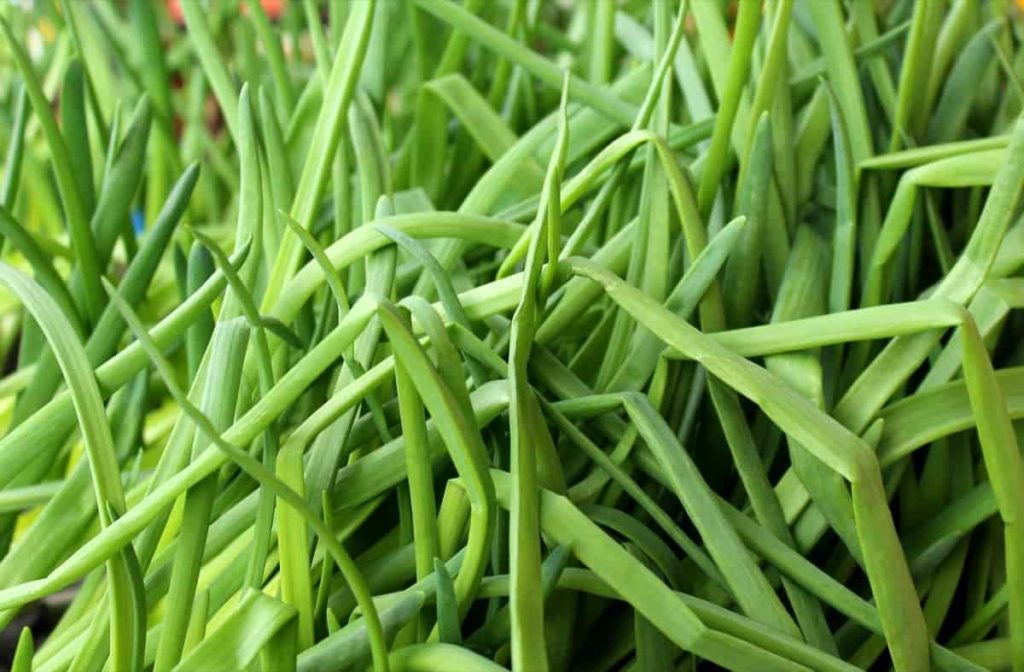
Insects
Chives are a very common reason why Chives can do bad things. Thrips are often the cause of the demise of a Chives plant as they suck the nutrients of the plant.
Solution – Use water spray or suitable pesticides to remove insects.
Diseases
The Chives are not very sensitive when suffering from fungus. However, there are exceptions where your Chive may be sick. The diseases are pink root rot, damping off disease, and downy mildew.
Solution – You should use fungicides to eliminate diseases.
Pests
Aphids
Aphids suck the sap from Chives plant leaves. This insect is not so threatening in cold temperatures.
Solution – The natural way to deal with the aphides is to shut them down using a strong water jet. You can use some liquid soap to wash them with Chives leaves.
Thrips
The thrips are small green pests that look like small sewing needles. They like to eat plants, and Chives are a source of trouble for farmers. They suck the juice from plants, which contributes to the growth of Chives.
Solution – You can use traps and pesticides to remove thrips.
Diseases
Damping-off disease
The damping-off disease appears as a white, blurred mold on the trunks of the Chives. Over time, the stem becomes black and falls as the plant dies. It mainly happens to young plants that are still growing. The disease affects seeds before they grow, killing them. If your Chive seedlings are falling, check them for damping-off disease.
Solution – Growing your seedlings in a cool, well-airy interior and thinning your seeds to stop moisture build-up. Avoid overwatering. Treatment of minor infections with home remedies like Chamomile and Garlic.
Pink root rot
Pink root rot disease causes light pink roots that turn red and then purple as the disease progresses. Since roots are affected, they cannot take the nutrients the plant needs. As a result, gardeners will see that the Chives plant is not growing and will ultimately die.
Solution – Water the soil deeply until it all gets soaked well. Cover this area with plastic, especially clear plastic. This type of plastic gives in very hot. Tick the plastic edges in the soil on the ends to ensure the heat is stuck. Let plastic stay in the hottest summer months for at least four weeks. The sun’s heat causes water to heat up in the soil and steam, but since plastic traps steam, it cannot survive. Instead, it constantly kills fungi and pathogens in the soil.
In case you missed it: How to Grow Berries in USA: At Home in Pots, Containers, Indoors, and Tips
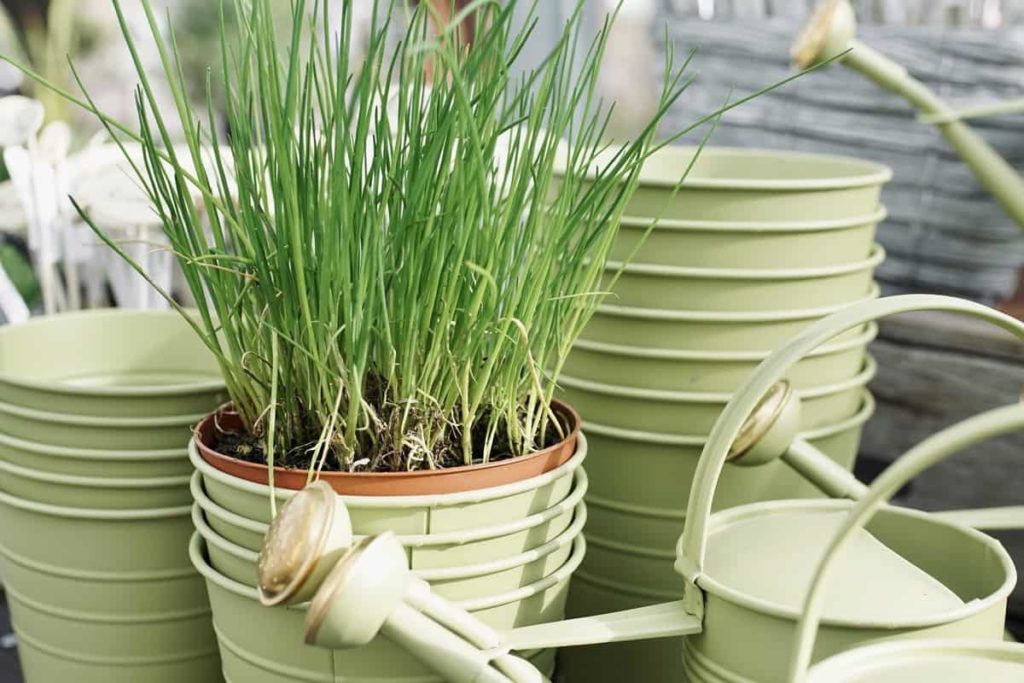
Downy mildew
The disease is characterized by powdery and downy mildew on the leaves of the Chives. Powdery mildew is on the top of the leaves, while downwards is Downy Mildew. As the fungi gradually spread their spores, it turns black and kills the leaves.
Solution– After planting the Chives crop, ensure that you apply non-allium crops for 3 to 4 years to reduce this fungus. Alternatively, you can plant Downy mildew-resistant varieties of Chives. You can also apply fungicides.
Conclusion
Chives are low-maintenance perennial plants. Their onion-flavored leaves are milder than green, yellow, and red onions, making them a great addition to any dish. If you are having trouble growing Chives, it is time to look at the health-impact factors of these plants, including nutrient deficiencies, water-filled soils, pests, and diseases.
To increase your production, you also need to address issues like providing the right amount of light and removing weeds. You should consider not the only factors when looking for a healthy crop also read on for additional information about the problems.
- How to Grow Hibiscus from Flower
- Plantation Ideas for Home Decoration: A Beginners Guide
- Flower Garden Designs and Layouts for Beginners
- Planting and Spacing Techniques in Papaya: A Beginner’s Guide
- Growing Gold: Essential Techniques for Planting Pineapples
- How to Make Kalanchoe Plant Bushy: Home Remedies and Solutions
- 11 Reasons Why Your Gardenia is Not Blooming: Home Remedies and Solutions
- Eco Elegance: The Guide to Designing a Drought-Tolerant Landscape
- Gardening on a Slope: Strategies for Hillside Landscaping
- Nourish and Flourish: Top Organic Mulches for Thriving House Plants
- Everything You Want to Know about Indian Mogra Flower: Discover Uses and Growing
- Green Thumb Success: Expert Tips for Cultivating Greenhouse Pumpkins All Year Round
- Maximize Growth & Flavor: The Ultimate Guide to Companion Planting in Herb Gardens
- How to Control Rhododendron Problems Naturally: Home Remedies and Organic Ways to Fix Them
- Natural Magic: The Remarkable Benefits of Cinnamon for Plants
- Best Steps to Revive Dying Tulip with Natural and Organic Treatment
- 10 Reasons Why Your Angel Trumpet is Not Blooming: Remedies and Treatment
- How to Fix Periwinkle Leaf and Flower-Related Problems: Natural Remedies and Solutions
- How to Fix Zinnias Leaf and Flower Problems: Discover Natural and Home Remedies
- Organic Steps to Induce Lemon Tree Flowers: A Comprehensive Guide
- Bloom Booster: Crafting the Perfect Homemade Bougainvillea Fertilizer
- Optimizing Growth: A Guide to Applying NPK Fertilizer for Potted Plants
- 10 Best Homemade Fertilizers for Rubber Plant: DIY Recipes and Application Method
- How to Boost Female Pumpkin Flowers: Effective Steps for More Flowers and High Yields
- Transform Your Indoor Garden: Top Benefits of Pink Salt for Houseplants
- 10 Best Homemade Fertilizers for Peacock Plants (Calathea): Easy DIY Guide
- Unlock Blooms: 9 Reasons Why Your Potted Chrysanthemum is Not Blooming
- 8 Reasons Why Your Potted Hibiscus is Not Blooming: Fix it with Simple Solutions
- Unlock Blooms: 9 Key Reasons Your Potted Frangipani Won’t Flower
- 10 Reasons Why Is My Ice Plant Not Blooming: Remedies and Treatment
- 10 Reasons Why My Potted Hydrangea Not Blooming: Treatment and Remedies
- 10 Reasons Why is My Wisteria Not Blooming: Remedies and Treatment
- 10 Reasons Why is My Goldfish Plant Not Blooming: Remedies and Treatment
- Maximize Your Space: Ultimate Guide to Balcony Gardening with Grow Bags
- 10 Reasons Why Your Iris is Not Blooming: Remedies and Treatment
- 10 Reasons Why Your Anthurium Plant is Not Blooming: Treatment and Remedies